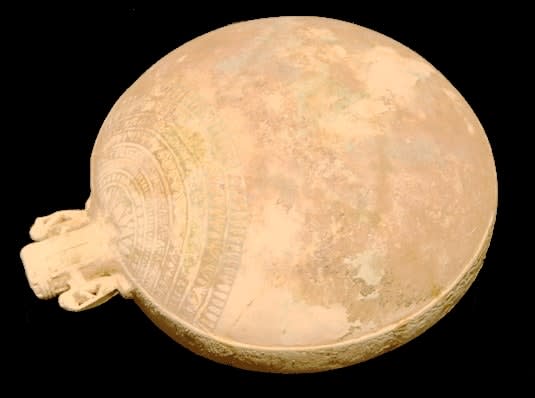Egyptian Pale Turquoise Glazed Pilgrim Flask, 664 BCE - 332 BCE
Terracotta
7
SK.022
This lentoid-shaped vessel, with a round narrow body, was designed for the celebration of the ancient Egyptian New Year. It was used to collect water from the Nile River during...
This lentoid-shaped vessel, with a round narrow body, was designed for the celebration of the ancient Egyptian New Year. It was used to collect water from the Nile River during late summer when it began to flood. This liquid was employed in rituals during New Year ceremonies which co-incided with the annual inundation. According to legend the flood was caused by the tears that the goddess Isis shed for her husband Osiris after he was murdered by his brother Seth. It was a crucial time in the Egyptian calendar and fraught with dangers that threatened the agricultural productivity of the land. Vessels such as this one were designed as part of the effort to ensure a harmonious transition. The gods most commonly invoked were Amun and Ptah as well as members of their triads: Sekhmet, Nefertum, Mut and Khonsu. This example has hieroglyphic inscriptions on each side, reading respectively, : ‘Neith [wishes] Happy New Year to its Lord’ and ‘Ptah [wishes] Happy New Year to its Lord.’ ‘Lord’ here refers to the flask’s owner who is not identified by name. Neith was one of the most ancient goddesses in the Egyptian pantheon and had many different associations. The most relevant in this context was probably her connection with the primordial waters of creation.
Each side of the flask has a broad wesekh (floral) collar and a squatting monkey either side of the short neck. In Egypt monkeys were often connected with the revitalizing female power of nature which ties in with the function of the flask. Raised bands of lotus, palmette and papyrus motifs encircle the upper part of the body. The surface has a delicate turquoise glaze of great beauty. Indeed the choice of colour may even tie in with the function of the vessel. In excellent condition, this elaborate and evocative flask will appeal to all serious collectors of Egyptian antiquities. (AM)
For other examples of this genre see, F. D. Friedman ed., ‘Gifts of the Nile: Ancient Egyptian Faience,’ pp. 229-230, nos. 126-127.
Each side of the flask has a broad wesekh (floral) collar and a squatting monkey either side of the short neck. In Egypt monkeys were often connected with the revitalizing female power of nature which ties in with the function of the flask. Raised bands of lotus, palmette and papyrus motifs encircle the upper part of the body. The surface has a delicate turquoise glaze of great beauty. Indeed the choice of colour may even tie in with the function of the vessel. In excellent condition, this elaborate and evocative flask will appeal to all serious collectors of Egyptian antiquities. (AM)
For other examples of this genre see, F. D. Friedman ed., ‘Gifts of the Nile: Ancient Egyptian Faience,’ pp. 229-230, nos. 126-127.
